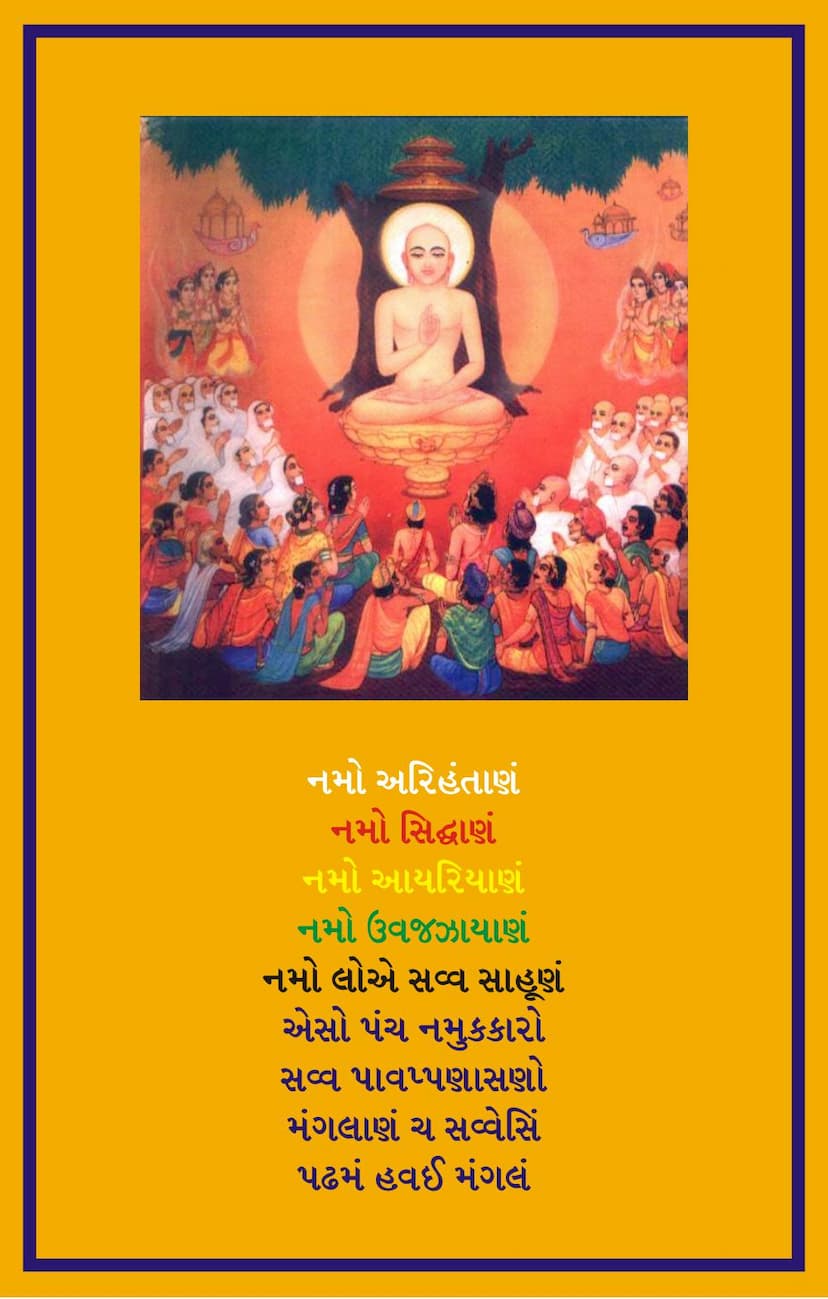Agam 01 Ang 01 Aacharang Sutra Part 01 Sthanakvasi
Added to library: September 1, 2025

Summary
Here's a comprehensive summary of the provided Jain text, focusing on the themes and teachings presented in the excerpt of the Ācārāṅga Sūtra (Part 1, Chapter 1, Sthānaka Tradition):
Book Title: Ācārāṅga Sūtra Part 01, Sthānaka Tradition Author: Ghasilal Maharaj Publisher: Akhil Bharat Shwetambar Sthanakvasi Jain Shastroddhar Samiti Key Focus: The provided text focuses on the "Ācārāṅga Sūtra," a fundamental text in Jainism, particularly as interpreted by the Sthānaka tradition. The excerpt predominantly covers introductory and explanatory sections, including mangalācaraṇa (auspicious invocation), author's dedication, publisher's details, and importantly, detailed guidelines regarding Aswadhyay (study of scriptures).
Core Themes and Teachings:
- Mangalācaraṇa (Auspicious Invocation): The text begins with the core Jain salutation: "Namo Arihantanam," "Namo Siddhanam," etc., acknowledging the five supreme beings (Pañca Namaskāra) as the destroyer of sins and the supreme auspiciousness.
2unAuthor and Publisher: The work is by Ghasilal Maharaj, with the publication by the Akhil Bharat Shwetambar Sthanakvasi Jain Shastroddhar Samiti. This highlights the specific lineage and tradition from which this commentary originates.
-
Ācārāṅga Sūtra's Importance: The title itself signifies the importance of "Ācāra" (conduct or behavior) in Jainism, and this sutra is considered a foundational text for monastic and lay conduct. The commentary by Ghasilal Maharaj, titled "Ācāra Cintāmaṇi," aims to elucidate the principles within the sutra.
-
Detailed Guidelines for Aswadhyay (Scriptural Study): A significant portion of the excerpt is dedicated to the rules and regulations surrounding the study of the Ācārāṅga Sūtra. These guidelines are meticulous and emphasize the importance of discipline and reverence during scriptural study. Key points include:
- Timing of Study: Specific times are recommended for studying the mūlapāṭha (original text), such as the first and fourth quarters of the day and night. Certain times (pre-dawn, dusk, noon, midnight) are designated for non-study periods or limited reading.
- Prohibited Times: Specific durations (e.g., 24 minutes before sunrise, 24 minutes after sunrise) are mentioned as times when study should not occur.
- Women in Menstruation: The text explicitly states that women in their menstrual period should not study or be present during the study, and that study should take place in rooms where such women are not present.
- Aswadhyay Präsanga (Inauspicious Circumstances): A comprehensive list of 32 "Aswadhyay Präsanga" (circumstances when study is prohibited) is provided, categorized into:
- 10 related to the sky (Ākāśa): These include meteor showers (Ulkāpāta), directional fires (Digdāha), loud thunder (Garjārava), celestial roaring (Nirdhāta), lightning (Vidyuta), specific lunar phase illuminations (Yūpaka), celestial lights (Yakṣāptam), black fog (Dhūmikā Kṛṣṇa), white fog (Mahikā Śveta), and dust storms (Rajo'ddhāta).
- 10 related to the physical body (Audārika Śarīra): These involve situations with bones, flesh, blood, broken eggs, excreta/urine, proximity to cremation grounds (Śmaśāna), lunar or solar eclipses, royal unrest (Rājavyāgrata), deaths of significant figures (Patana), and the presence of dead bodies (Audārika Śarīra).
- 8 related to Festivals and specific days: Four major festivals (Mahotsava) and the four days following them (Pratipadā) are listed as days when study is prohibited.
- Importance of Vinaya: The text concludes the Aswadhyay guidelines by emphasizing that vinaya (humility, respect) is the root of dharma and that in difficult situations, one should follow the wishes of the Guru or elders.
- Distinction for Translations: It's noted that these Aswadhyay rules apply to the mūlapāṭha (original text) and not necessarily to translations.
-
Structure of the Ācārāṅga Sūtra: The table of contents (Vishayanukram) reveals the extensive scope of the Ācārāṅga Sūtra, covering various aspects of Jain philosophy and practice. This includes:
- Avataraṇa (Introduction): Discussing the divine qualities of Tirthankaras' words, comparing them to the Kalpavriksha tree's flowers, and listing 25 similarities and 35 atishayas (extraordinary qualities) of the Tirthankaras' speech.
- Anuyoga (Discourse): The text categorizes discourses into four types:
- Caraṇakaraṇānuvoga: Primarily focused on monastic conduct, rules, and practices (detailed topics like pravrajyādāna (initiation), keśalochan (hair plucking), gocharī (alms-seeking), etc., are listed).
- Dharmakathānuvoga: Narratives and stories to teach dharma, including discussions on dharma's glory.
- Gaṇitānuvoga: Mathematical and astronomical discussions, crucial for determining auspicious times for religious activities like initiation.
- Dravyānuvoga: Discussions on the fundamental substances (dravyas) of Jainism—Dharma, Adharma, Akasha, Kala, Pudgala, and Jiva—detailing their characteristics, divisions, and interactions.
- Detailed Philosophical Concepts: The outline delves into detailed philosophical discussions on the nature of soul (Ātmavādi Prakaraṇ), the six substances (Ṣaḍ-dravya Vicāra), karma theory (Karmavādi Prakaraṇ), action theory (Kriyāvādi Prakaraṇ), and the six categories of life forms (Ṣaḍ-jīvanikāya).
-
Emphasis on Correct Conduct (Ācāra): The entire text revolves around the concept of "Ācāra," which is paramount in Jainism. The detailed listing of topics within the Dravyānuvoga, such as the characteristics of soul, karma, and the six substances, underpins the principles of right conduct.
-
Commentary's Purpose: Ghasilal Maharaj's commentary, "Ācāra Cintāmaṇi," is presented as a means to understand the profound teachings of the Ācārāṅga Sūtra, bringing clarity and aiding in the practice of dharma for the welfare of beings.
In essence, this excerpt from the Ācārāṅga Sūtra, presented by Ghasilal Maharaj, serves as a comprehensive introduction to Jain philosophy and practice, with a strong emphasis on the disciplined approach required for scriptural study, a deep dive into metaphysical concepts like the six substances, and ultimately, the foundation for ethical and spiritual conduct. The extensive detail on aswadhyay rules underscores the reverence and systematic approach required in Jain spiritual learning.